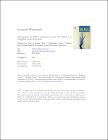| dc.contributor.author | BUCKLEY, CONOR TIMOTHY | |
| dc.date.accessioned | 2012-02-29T12:20:18Z | |
| dc.date.available | 2012-02-29T12:20:18Z | |
| dc.date.issued | 2012 | |
| dc.date.submitted | 2012 | en |
| dc.identifier.citation | Cox G., Boxhall S., Giannoudis P.V., Buckley C.T., Roshdy T., Churchman S.M., McGonagle D. and Jones E.:, High abundance of CD271+ multipotential stromal cells (MSCs) in intramedullary cavities of long-bones, Bone, 50, 2, 2012, 510-517 | en |
| dc.identifier.other | Y | |
| dc.identifier.uri | http://hdl.handle.net/2262/62413 | |
| dc.description | PUBLISHED | en |
| dc.description.abstract | Aspiration of iliac crest bone marrow (ICBM) remains the most frequent technique used in harvesting multipotential stromal cells (MSCs) for bone regeneration. Although this tissue type is easily accessed by a surgeon, it has a low frequency of MSCs, which is significant given the high cell numbers required for bone regeneration strategies. Lipoaspirates possess higher MSC frequencies, albeit cells with a differentiation profile less suited to orthopaedic interventions. Intra-medullary cavities of long bones have previously been shown to harbour MSCs in animals, however evaluation of their frequency, differentiation capacity and phenotype in humans had not previously been performed.
Long bone fatty bone marrow (LBFBM) was collected prior to harvesting bone graft. Basic cellular compositions of donor-matched LBFBM and ICBM aspirates, including the numbers of CD34+ hematopoietic stem cells and CD31+ endothelial cells, were similar. MSCs were enumerated using colony-forming-unit-fibroblast assays and flow cytometry for the presence of a resident LBFBM CD45?/low CD271+ MSC population and revealed a trend for higher MSC numbers (average 5 fold, n = 6) per millilitre of LBFBM compared to donor-matched ICBM. Functional characteristics of resident MSCs, including their growth rates, differentiation potentials and surface phenotypes (CD73+CD105+CD90+) before and after culture-amplification, were similar. Enhanced numbers of MSCs could be recovered following brief enzymatic treatment of solid fragments of LBFBM.
Our findings therefore reveal that the intramedullary cavity of the human femur is a depot of MSCs, which, although closely associated with fat, have a differentiation profile equivalent to ICBM. This anatomical site is frequently accessed by the orthopaedic/trauma surgeon and aspiration of the intramedullary cavity represents a `low-tech? method of harvesting MSCs for regenerative therapies and research. | en |
| dc.format.extent | 510-517 | en |
| dc.language.iso | en | en |
| dc.relation.ispartofseries | Bone; | |
| dc.relation.ispartofseries | 50; | |
| dc.relation.ispartofseries | 2; | |
| dc.rights | Y | en |
| dc.subject | Bone regeneration | en |
| dc.subject | Multipotential stromal cells | en |
| dc.subject | Mesenchymal stem cells | en |
| dc.title | High abundance of CD271+ multipotential stromal cells (MSCs) in intramedullary cavities of long-bones | en |
| dc.type | Journal Article | en |
| dc.type.supercollection | scholarly_publications | en |
| dc.type.supercollection | refereed_publications | en |
| dc.identifier.peoplefinderurl | http://people.tcd.ie/cbuckle | |
| dc.identifier.rssinternalid | 74263 | |
| dc.identifier.rssuri | http://dx.doi.org/10.1016/j.bone.2011.07.016 | en |




